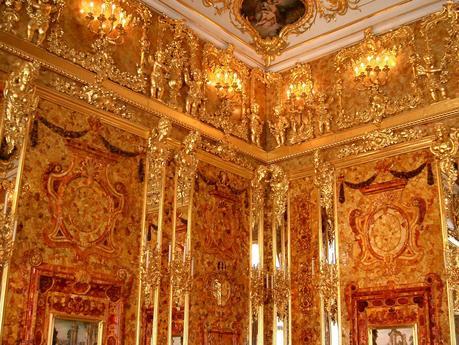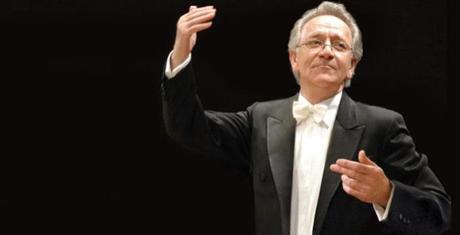
Detail from a modern replica of the Amber Room,
located in the Catherine Palace near St. Petersburg, Russia.
The Amber Room is lost to history, but its qualities of richness and warmth could be heard Wednesday night at Carnegie Hall, when the St. Petersburg Symphony Orchestra played the first of two dates at Carnegie Hall under the sure baton of Yuri Temirkanov. The SPSO is Russia's oldest orchestra, founded in 1882 at the order of Tsar Alexander III. They are imbued with dark, rich orchestral tone, featuring throaty brass, warm strings and woodwinds that bring a personal, questioning voice to the most challenging solo parts.

Yuri Temirkanov. Photo © 2009 Medici TV.
The concert opened with Kikimora, a tone poem by Antonin Liadov. Liadov was a Rimsky pupil, whose sparse output has consigned him to minor status. Kikimora is based on an equally obscure fairy tale. But the story inspired Liadov to write innovative orchestration with rich rhythms and an imaginative solo part for the English horn.The orchestra was then joined by pianist Nicholas Lugansky for Rachmaninoff's Second Piano Concerto. Though it does not share the Everest status of the Third, this is still a fiendishly difficult work that is challenging to bring off. Rachmaninoff possessed a formidable hand-stretch which presents difficulty for soloists playing his music.
Mr. Lugansky brought impressive physical tools and technique to the keyboard, a wide finger-stretch and a command over the pedal and liquid runs required in the first and third movements. The second movement was the highlight, a slow meditative wander through the subconscious, shot through with the melancholy melodies that are a calling card of this composer.
The second half of the evening was dominated by Scheherezade, Nikolai Rimsky-Korsakov's retelling of the Arabian Nights. This is really an extended four-movement concerto for orchestra, with different soloists and groups of instruments taking the part of characters in these famous stories. The Sea and Sinbad's Ship featured eloquent violin soliloquys from concertmaster Lev Klychkov, in an engrossing call-and-response with his orchestra and Mr. Temirkanov.
Other instruments stepped to the fore as the tales spun on. The Kalandar Prince featured powerful brass playing in perfect balance with the rest of the orchestra. The Young Prince and the Princess highlighted the woodwinds. And finally the whole orchestra roared forth in a mighty voice for The Ship Breaks Against the Cliff, before coming to a transcendent, almost Wagnerian conclusion in the final bars. This spectacular performance was met with an enthusiastic reception, and the appreciative audience earned a brief, scintillating encore.

